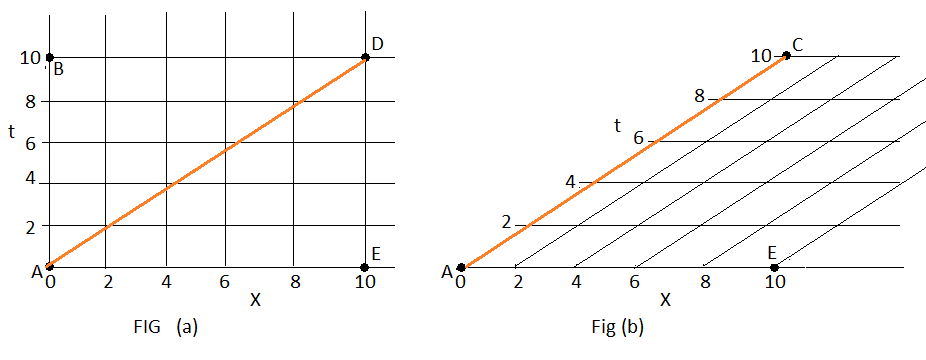These are some further important queries regarding the question here Why would spacetime curvature cause gravity?
Q1. Explain the statement “Everything in spacetime moves at the speed of light”. Is this statement even true or false? My naïve understanding is as follows: If an object is stationary in space (relative to an observer?) then it will be moving in time, so, it will, say, move from (x=0,t=0) to (x=0,t=10). The velocity is the space interval / time interval, which from above coordinates is still zero. So it is moving through spacetime, but at zero velocity. So velocity will just determine the angle of its path to the time axis. If this angle is zero, ie it is moving parallel to the time axis, then velocity = zero, and it can really move in time from one time point to the other at zero velocity. Where am I wrong, and what is the real explanation?
Q2. Suppose there are two objects (see fig), an apple A above the earth at x=0, and the earth E at x=10 as shown in the fig. If there is no earth and just the apple in open space, then the spacetime is not curved due to the gravity of the earth, and the apple stays at x=0 but moves in time from A to B (fig a). Now the earth is at x=10 and presumably the spacetime curves and the axes tilt as in fig b. Then the apple moves from A to C, just following the geodesic. But if we assume this, then the apple has not moved at all, because, due to the tilt of the axis, point C is also at x=0. So fig b cannot be the correct situation, otherwise the apple will arrive at point C which is still on the x=0 axis. So I assume that in fact the apple has not moved from A to C in fig b, but has moved from A to D in fig. a, where D is really at x=10. But if I assume this, then it is not spacetime itself that has curved. The spacetime is still straight, but the apple has moved from (x=0,t=0) to (x=10,t=10). Again, where am I wrong, and what is the correct explanation? How exactly has the spacetime curved or tilted for the apple at A due to the presence of the Earth at E, and how does the apple move to the earth by following the geodesic in free fall? (assume only one spatial dimention)

Q3: We say that gravity is not just a “force of attraction” between two pieces of mass, and it does not “pull” the two pieces of mass towards each other. Instead, acceleration is manifested because the two pieces of mass are simply following their now curved geodesics. But it can be shown that there really is an attractive force due to gravity. E.g. Take the apple in the earth’s gravity and suspend it on a spring balance. The spring will extend. Yes, you can say that since it is suspended motionless, so it is no longer in free fall, and since the spring balance exerts an external force upwards on the apple, so it no longer follows its free fall geodesic. But it is not only the spring balance which is exerting an upward force on the apple. The apple is also exerting a downward force on the spring, which causes the spring to extend. Surely it is too naïve to say that the downward force which the earth exerts on the apple and in turn the apple exerts on the spring suddenly vanishes if the apple is released into free fall.
If two masses were remotely attracting each other with a force, why would they cease to attract each other with a force when in free fall? It is logically a much more satisfying explanation that the gravitational attraction force which was there at rest remains in free fall too and it is this gravitational attraction force which causes the freefall acceleration by F=ma, just like any force on any object would cause an acceleration. Also, it is the net force on the object which causes the acceleration. When the object was suspended, the net force was zero, so acceleration was zero. When in free fall, the net force IS THE GRAVITATIONAL ATTRACTION FORCE, so acceleration is accordingly. This seems totally opposite to the statement that there is no gravitational force in free fall.
The reason why the spring of the spring balance does not extend when in free fall is that there IS a gravitational force downwards, but there is no force exerted by the spring upwards, so the net force on the object is downwards due to gravity, which causes the acceleration F=ma. Where am I wrong? What is the correct explanation?

